 We've recently started taco evenings with the children and they've been a roaring success. I suppose it's the spread of food in front of them and the feeling of building your own meal that appeals to them. We're sharing everything together and I think it means they feel quite grown up and part of the fun.Usually, I'll just make a chicken dish seasoned with cumin, oregano, chilli and other bits and pieces (we call it taco seasoning, it could be called adobo spices), but this time I got the heavy guns out and went a bit nuts. There was plenty left over which went in freezer bags for next time, so it wasn't as crazy as it looked when I lay it all down. I'd suggest picking one or two dishes depending on how many people you're feeding and depending on how long you want to spend in the kitchen. I was in a food frenzy, you may not want to be.Whatever you do, you must serve the tacos with guacamole, sour cream, chopped tomatoes and grated cheddar.The dishes we had are as follows (deep breath):Homemade corn tortillas, guacamole, pico de gallo, adobo sauce, chicken with taco seasoning, red onion pickle, sour cream, slow cooked shredded pork cheek with barbecue sauce, fried prawns with Old Bay seasoning, lime and coriander mayonnaise, shredded gem lettuce,spring onions, coriander leaves and lime wedges.All this for an early evening supper with the kids. Totally bonkers and never again on such a scale, unless someone pays me.The children loved making the tortillas though, and if you don't have a tortilla press (they're cheap and available on mexgrocer.co.uk along with almost everything you may need for mexican receipes) you may want to save yourself the bother and buy corn tortillas ready-made. Of course, they're not as good and often have wheat flour in but if it saves your nerves from becoming as shredded as the pork, then it's probably a good thing.The pickled red onion recipe is here, but for the rest (apart from guacamole, I'm not going to bother giving a recipe for that) hold your breath and keep reading.Corn Tortillas:One part masa harina (corn flour) to one part warm water and a pinch of salt.Simply mix the ingredients together until they form a dough much like 'playdoh', leave to rest and then form into small balls and press between sheets of plastic (I used a cut up ziplock sandwich bag) on the tortilla maker. Cook on a volcanic cast-iron griddle pan until both sides are tortilla-like then throw on a plate and continue until you have a pile of them. Cover and leave until you're ready to eat.Pico de Gallo:This is essentially a fiery tomato salsa, but here, I've left the cherry tomatoes quite large so it's a little like a salad. Just mix together a load of chopped cherry tomatoes, some finely sliced onions, a chopped serrano chilli, some fresh coriander, salt and a good squeeze of lime juice. Leave to rest for about twenty minutes before serving.Adobo Sauce:I soaked a large dried ancho and chipotle chilli in hot water for about half an hour then blended it with a thumb of ginger a tablespoon of ground cumin and a pinch of salt. That's it. It's pretty intense and sharp, but goes really well with the other dishes.Chicken with Taco Seasoning:Take one chicken breast and slice it thinly across. Toss it in a bowl with as much as you feel of paprika, pepper, onion powder, oregano, cumin, garlic powder, salt, chilli powder and ground coriander. Why don't you start with equal amounts of each, see what you like and adjust it from there. Then, as I have done, you can make a big jar of it and you've got tacos a-go-go hey presto!Sauté the chicken in a hot frying pan with some olive oil until cooked. Add a splash of water at the end to deglaze the pan and pour everything into a bowl.Shredded Pork in Barbecue Sauce:This is a slow-cooker winner. I now buy all my meat from the incredible Anne Petch at Heal Farm in Devon. It's close to the supermarket prices and miles above in quality and welfare. She sends it by courier the next day and I cannot recommend her highly enough. I discovered her in Jane Grigson's 'English Food' and was delighted to find she's online and thriving. I felt I knew the pigs I was eating, and being in London feel much more connected to the food as is possible in a city.Take one onion, two cloves of garlic and 500g of pork cheek (diced) and brown them in a pan with some olive oil. Season well and add to the slow cooker.Add one sliced green chilli and some dried thyme sprigs and turn the slow cooker onto high. If you don't have one, you could cook this in a casserole in a low oven for the same amount of time.Make the barbecue sauce by stirring together: 1tsp tomato purée, a pinch of coconut sugar (or brown if you don't have any), a good squeeze of lime juice, probably about a lime's worth, a large pinch (depending on the size of your fingers) of garlic powder, some chilli powder, Cayenne pepper, thyme leaves, dried oregano, ground cumin, finely diced onion, chipotle paste, a good splash of Worcestershire sauce, a spoonful of Dijon mustard and some tabasco sauce. As for exact amounts, just trust your nose and instincts. I make mine with varying pinch sizes every time and it's always delicious.Add the barbecue sauce to the pork cheeks, stir well and cook with the lid on on high for four hours. Cool a little and shred with a pork. Pour into a bowl to serve. This one's a winner the next day in a sandwich too.Fried Prawns with Old Bay Seasoning:Or shrimp, as the Americans would have it, is a version of the famous fish taco. You can buy Old Bay here and I'd recommend a box for the packaging alone. I made a quick batter with flour, sparkling water and a good few spoons of Old Bay then deep-fried them until crisp. Easy as that.Lime and Coriander Mayonnaise:Make some mayonnaise and stir in some lime juice, lime zest, pepper and chopped coriander. What else do you want to know?And that's pretty much all you need for a taco party. Just make sure you're wearing elasticated trousers and have no plans for the evening. Even if you're having these at lunchtime.
We've recently started taco evenings with the children and they've been a roaring success. I suppose it's the spread of food in front of them and the feeling of building your own meal that appeals to them. We're sharing everything together and I think it means they feel quite grown up and part of the fun.Usually, I'll just make a chicken dish seasoned with cumin, oregano, chilli and other bits and pieces (we call it taco seasoning, it could be called adobo spices), but this time I got the heavy guns out and went a bit nuts. There was plenty left over which went in freezer bags for next time, so it wasn't as crazy as it looked when I lay it all down. I'd suggest picking one or two dishes depending on how many people you're feeding and depending on how long you want to spend in the kitchen. I was in a food frenzy, you may not want to be.Whatever you do, you must serve the tacos with guacamole, sour cream, chopped tomatoes and grated cheddar.The dishes we had are as follows (deep breath):Homemade corn tortillas, guacamole, pico de gallo, adobo sauce, chicken with taco seasoning, red onion pickle, sour cream, slow cooked shredded pork cheek with barbecue sauce, fried prawns with Old Bay seasoning, lime and coriander mayonnaise, shredded gem lettuce,spring onions, coriander leaves and lime wedges.All this for an early evening supper with the kids. Totally bonkers and never again on such a scale, unless someone pays me.The children loved making the tortillas though, and if you don't have a tortilla press (they're cheap and available on mexgrocer.co.uk along with almost everything you may need for mexican receipes) you may want to save yourself the bother and buy corn tortillas ready-made. Of course, they're not as good and often have wheat flour in but if it saves your nerves from becoming as shredded as the pork, then it's probably a good thing.The pickled red onion recipe is here, but for the rest (apart from guacamole, I'm not going to bother giving a recipe for that) hold your breath and keep reading.Corn Tortillas:One part masa harina (corn flour) to one part warm water and a pinch of salt.Simply mix the ingredients together until they form a dough much like 'playdoh', leave to rest and then form into small balls and press between sheets of plastic (I used a cut up ziplock sandwich bag) on the tortilla maker. Cook on a volcanic cast-iron griddle pan until both sides are tortilla-like then throw on a plate and continue until you have a pile of them. Cover and leave until you're ready to eat.Pico de Gallo:This is essentially a fiery tomato salsa, but here, I've left the cherry tomatoes quite large so it's a little like a salad. Just mix together a load of chopped cherry tomatoes, some finely sliced onions, a chopped serrano chilli, some fresh coriander, salt and a good squeeze of lime juice. Leave to rest for about twenty minutes before serving.Adobo Sauce:I soaked a large dried ancho and chipotle chilli in hot water for about half an hour then blended it with a thumb of ginger a tablespoon of ground cumin and a pinch of salt. That's it. It's pretty intense and sharp, but goes really well with the other dishes.Chicken with Taco Seasoning:Take one chicken breast and slice it thinly across. Toss it in a bowl with as much as you feel of paprika, pepper, onion powder, oregano, cumin, garlic powder, salt, chilli powder and ground coriander. Why don't you start with equal amounts of each, see what you like and adjust it from there. Then, as I have done, you can make a big jar of it and you've got tacos a-go-go hey presto!Sauté the chicken in a hot frying pan with some olive oil until cooked. Add a splash of water at the end to deglaze the pan and pour everything into a bowl.Shredded Pork in Barbecue Sauce:This is a slow-cooker winner. I now buy all my meat from the incredible Anne Petch at Heal Farm in Devon. It's close to the supermarket prices and miles above in quality and welfare. She sends it by courier the next day and I cannot recommend her highly enough. I discovered her in Jane Grigson's 'English Food' and was delighted to find she's online and thriving. I felt I knew the pigs I was eating, and being in London feel much more connected to the food as is possible in a city.Take one onion, two cloves of garlic and 500g of pork cheek (diced) and brown them in a pan with some olive oil. Season well and add to the slow cooker.Add one sliced green chilli and some dried thyme sprigs and turn the slow cooker onto high. If you don't have one, you could cook this in a casserole in a low oven for the same amount of time.Make the barbecue sauce by stirring together: 1tsp tomato purée, a pinch of coconut sugar (or brown if you don't have any), a good squeeze of lime juice, probably about a lime's worth, a large pinch (depending on the size of your fingers) of garlic powder, some chilli powder, Cayenne pepper, thyme leaves, dried oregano, ground cumin, finely diced onion, chipotle paste, a good splash of Worcestershire sauce, a spoonful of Dijon mustard and some tabasco sauce. As for exact amounts, just trust your nose and instincts. I make mine with varying pinch sizes every time and it's always delicious.Add the barbecue sauce to the pork cheeks, stir well and cook with the lid on on high for four hours. Cool a little and shred with a pork. Pour into a bowl to serve. This one's a winner the next day in a sandwich too.Fried Prawns with Old Bay Seasoning:Or shrimp, as the Americans would have it, is a version of the famous fish taco. You can buy Old Bay here and I'd recommend a box for the packaging alone. I made a quick batter with flour, sparkling water and a good few spoons of Old Bay then deep-fried them until crisp. Easy as that.Lime and Coriander Mayonnaise:Make some mayonnaise and stir in some lime juice, lime zest, pepper and chopped coriander. What else do you want to know?And that's pretty much all you need for a taco party. Just make sure you're wearing elasticated trousers and have no plans for the evening. Even if you're having these at lunchtime.






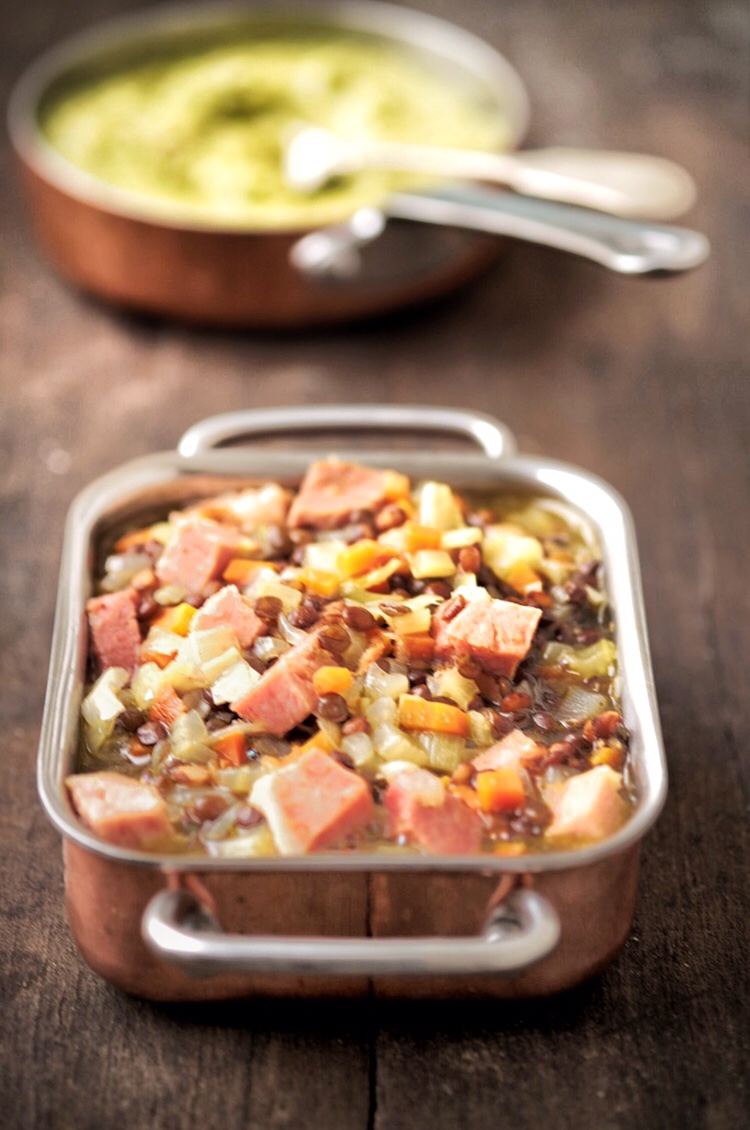 The warm smell of cooking as you get in from school is like a blanket covering you on the sofa in winter or a hot chocolate by the fire. My favourite, the one that always said something good was on the way, was -- and still is -- garlic and onions softly sautéeing in olive oil. That, for me, was when I knew there is some proper food coming, something prepared and cooked with care and attention, something that says "you are being nurtured". You can't smell a salad, can you?I do quite often cook the children fish fingers and peas for supper; sometimes we're all on the edge of sanity and even slicing an onion may just break me. And sometimes, I'll work over a hot stove for hours, wiping my brow with the towel of martyrdom just for the children to decide on a whim they don't like something they've wolfed down countless times before. They'll never turn down a roast on Sunday though. Sometimes you can never win, and sometimes, they'll surprise you by loving sparrow soufflé with chillies. But knowing there's always a hot meal on its way, and the kitchen is a place of happiness is something we all need.This recipe is perfect to fill the house with the kinds of smells to make you feel happy. The aromatic vegetables softening, the slight spice from the garam masala, the fresh bay leaves. And the simmering broth. It's also quick, if you take into account that you can cheat by using tinned cooked green lentils. But even if you cook them from scratch, it still doesn't take forever. I've made a courgette purée to go with it -- lentils are quite filling -- but if you feel like mashed potato instead, go for it.Ingredients200g cooked ham chunks. I had some in the freezer left over from Christmas250g cooked green lentils1 carrot1 stick of celery, plus leaves1 small onionThe white of a leek you've had hanging around for a few days2 fresh bay leavesChicken stock to cover1tbsp garam masalaSalt and white pepper to seasonFor the courgette:1 largeish courgette2 shallots1 fat clove of garlicOlive oilA tablespoon or two of butterSalt to seasonMethodSlice the carrots, celery, onion and leek into dice as small as you can manage.Heat a saucepan with some olive oil and throw them in. Add the bay leaves, season and stir.Cook gently for ten minutes until softened then add the ham, lentils, garam masala, seasoning and stock.Bring to the boil for a few minutes then simmer for a further ten with a lid on.Make the courgettes by heating a sauté pan with some olive oil then adding the garlic and shallot. Season well and cook for a few minutes, until starting to colour.Turn the heat up and add the courgettes, toss around and cook until turning golden here and there.Transfer to a blender or food processor, add the butter and blend to a purée. Taste and adjust the seasoning. It probably needs more salt. And butter.Serve with the lentils and ham.
The warm smell of cooking as you get in from school is like a blanket covering you on the sofa in winter or a hot chocolate by the fire. My favourite, the one that always said something good was on the way, was -- and still is -- garlic and onions softly sautéeing in olive oil. That, for me, was when I knew there is some proper food coming, something prepared and cooked with care and attention, something that says "you are being nurtured". You can't smell a salad, can you?I do quite often cook the children fish fingers and peas for supper; sometimes we're all on the edge of sanity and even slicing an onion may just break me. And sometimes, I'll work over a hot stove for hours, wiping my brow with the towel of martyrdom just for the children to decide on a whim they don't like something they've wolfed down countless times before. They'll never turn down a roast on Sunday though. Sometimes you can never win, and sometimes, they'll surprise you by loving sparrow soufflé with chillies. But knowing there's always a hot meal on its way, and the kitchen is a place of happiness is something we all need.This recipe is perfect to fill the house with the kinds of smells to make you feel happy. The aromatic vegetables softening, the slight spice from the garam masala, the fresh bay leaves. And the simmering broth. It's also quick, if you take into account that you can cheat by using tinned cooked green lentils. But even if you cook them from scratch, it still doesn't take forever. I've made a courgette purée to go with it -- lentils are quite filling -- but if you feel like mashed potato instead, go for it.Ingredients200g cooked ham chunks. I had some in the freezer left over from Christmas250g cooked green lentils1 carrot1 stick of celery, plus leaves1 small onionThe white of a leek you've had hanging around for a few days2 fresh bay leavesChicken stock to cover1tbsp garam masalaSalt and white pepper to seasonFor the courgette:1 largeish courgette2 shallots1 fat clove of garlicOlive oilA tablespoon or two of butterSalt to seasonMethodSlice the carrots, celery, onion and leek into dice as small as you can manage.Heat a saucepan with some olive oil and throw them in. Add the bay leaves, season and stir.Cook gently for ten minutes until softened then add the ham, lentils, garam masala, seasoning and stock.Bring to the boil for a few minutes then simmer for a further ten with a lid on.Make the courgettes by heating a sauté pan with some olive oil then adding the garlic and shallot. Season well and cook for a few minutes, until starting to colour.Turn the heat up and add the courgettes, toss around and cook until turning golden here and there.Transfer to a blender or food processor, add the butter and blend to a purée. Taste and adjust the seasoning. It probably needs more salt. And butter.Serve with the lentils and ham.
 Now the Christmas tree has been cut up and put in the bin by the dead of night and the year gently settles into itself, I find myself staring out timidly from the duvet, slightly scared of the outside world.The fondue set has also been put back into storage; it is a dish we only get round to on new year's eve. This time we had thin cubes of beef fillet tail and dipped them in hot melted butter, loaded with grated garlic or a punchy, herb-laced olive oil. A game of Jenga later and we were all tucked up in bed well before Big Ben bonged.It's now back to more normal meals, things we can leave to bubble in a pan for an hour or two, or cook gently in the oven on the weekends behind the scenes for use midweek while trying to find socks for school tomorrow.In that vein then, here is a comforting bean dish that is rich, easy and nourishing. There is no need to soak the beans overnight, cook them from dried for an hour and a half, they are more flavoursome and equally as tender. You could, if you prefer, use tinned, cooked haricots, making this even quicker and easier to bring together and perhaps something you would make on a cold January Wednesday.For this recipe, I used the stock I'd made from the chicken left over from Saturday's lunch of pot roast chicken which I'd cooked on leeks, garlic, lemon and onions. A good few handfuls of cubed leftover ham went in and then to serve it, I made a roux, loosened it with the juices from the chicken and blended in a little double cream. It was rather like a chicken, leek and ham pie without the pastry, and none the worse for that. In the past, with equal success, I've used on of those little gel stock pots. Whatever you've got.You can have this with a quickly seared and caramelised pork chop, on it's own pretending you're a cowboy, or like we did this week with some shredded savoy cabbage, buttery and sloshed with lemon juice and pepper. There was a howling wind that night, and this is real food for those dark winter evenings of which we still have quite a few ahead.Ingredients100g haricot beans500-600ml boiling water1 celery stick1 medium carrot1 small onion100g chorizo180ml chicken stock2 fresh bay leavesParsley to serveSalt and pepper to seasonMethodPut the beans straight into the saucepan of boiling water with a little salt and simmer gently for an hour and a half. Keep an eye on it to make sure it doesn't boil dry. Most of the liquid will be absorbed by the end. You can leave them to cool and use later, or keep refrigerated for the next day.Cube the chorizo, quite small, and fry in a sauté pan on a fairly gentle heat until the rust orange oil comes out. Add the bay leaves.Finely dice the celery, carrot and onion and add to the pan. You could blitz them in the food processor if you prefer, but I like to chop by hand, to be a little more connected to the food. There are enough machines in our lives, if you've got time to go on Facebook, you've got time to chop an onion. And to be honest, I'll let the machines do the rubbish bits like washing up.Stir well and cook gently until softened. Season a little and cook gently for about ten minutes.Add the beans and stock, bring to the boil and then simmer for about five minutes before serving with a good amount of black pepper and chopped parsley.If there is any left, you could serve it for lunch the next day with a crisp fried egg, the yolk mixing in to be scooped up with a good slice of toasted and buttered bread.This weekWatched: '
Now the Christmas tree has been cut up and put in the bin by the dead of night and the year gently settles into itself, I find myself staring out timidly from the duvet, slightly scared of the outside world.The fondue set has also been put back into storage; it is a dish we only get round to on new year's eve. This time we had thin cubes of beef fillet tail and dipped them in hot melted butter, loaded with grated garlic or a punchy, herb-laced olive oil. A game of Jenga later and we were all tucked up in bed well before Big Ben bonged.It's now back to more normal meals, things we can leave to bubble in a pan for an hour or two, or cook gently in the oven on the weekends behind the scenes for use midweek while trying to find socks for school tomorrow.In that vein then, here is a comforting bean dish that is rich, easy and nourishing. There is no need to soak the beans overnight, cook them from dried for an hour and a half, they are more flavoursome and equally as tender. You could, if you prefer, use tinned, cooked haricots, making this even quicker and easier to bring together and perhaps something you would make on a cold January Wednesday.For this recipe, I used the stock I'd made from the chicken left over from Saturday's lunch of pot roast chicken which I'd cooked on leeks, garlic, lemon and onions. A good few handfuls of cubed leftover ham went in and then to serve it, I made a roux, loosened it with the juices from the chicken and blended in a little double cream. It was rather like a chicken, leek and ham pie without the pastry, and none the worse for that. In the past, with equal success, I've used on of those little gel stock pots. Whatever you've got.You can have this with a quickly seared and caramelised pork chop, on it's own pretending you're a cowboy, or like we did this week with some shredded savoy cabbage, buttery and sloshed with lemon juice and pepper. There was a howling wind that night, and this is real food for those dark winter evenings of which we still have quite a few ahead.Ingredients100g haricot beans500-600ml boiling water1 celery stick1 medium carrot1 small onion100g chorizo180ml chicken stock2 fresh bay leavesParsley to serveSalt and pepper to seasonMethodPut the beans straight into the saucepan of boiling water with a little salt and simmer gently for an hour and a half. Keep an eye on it to make sure it doesn't boil dry. Most of the liquid will be absorbed by the end. You can leave them to cool and use later, or keep refrigerated for the next day.Cube the chorizo, quite small, and fry in a sauté pan on a fairly gentle heat until the rust orange oil comes out. Add the bay leaves.Finely dice the celery, carrot and onion and add to the pan. You could blitz them in the food processor if you prefer, but I like to chop by hand, to be a little more connected to the food. There are enough machines in our lives, if you've got time to go on Facebook, you've got time to chop an onion. And to be honest, I'll let the machines do the rubbish bits like washing up.Stir well and cook gently until softened. Season a little and cook gently for about ten minutes.Add the beans and stock, bring to the boil and then simmer for about five minutes before serving with a good amount of black pepper and chopped parsley.If there is any left, you could serve it for lunch the next day with a crisp fried egg, the yolk mixing in to be scooped up with a good slice of toasted and buttered bread.This weekWatched: '
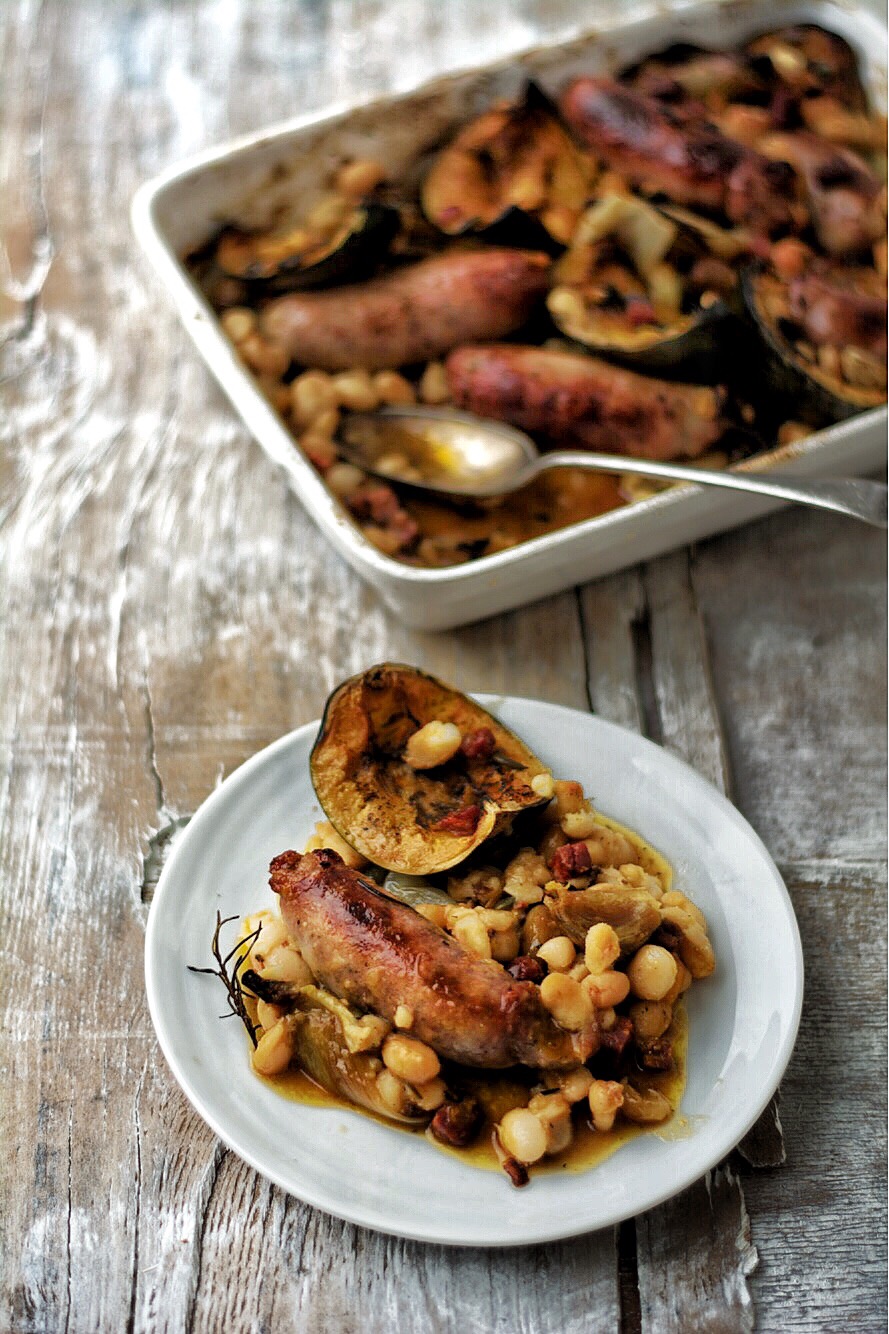 The half term holidays are over and Noah and Maya have been pressed, polished and painted and sent back to school looking less like stig-of-the-dump and more like human children. Quite an achievement, I think.We spent the week in less of a rush than usual, a nice change to the routine and lovely to have the little blighters around more. Tuesday found us bowling. I'm sure it wasn't as obscenely expensive when I was a teenager, trying to look cool in my huge '80s clothes. Maybe it's me, or maybe every activity these days is genuinely out to fleece you for as much as possible. A child in the queue ahead of us had just vomited on the floor by the ticket desk. Whether or not that was excitement, overindulgence, or shock at the cost I'm not sure. The noise, wild-eyed children and flashing lights made me feel like doing the same.And then, 'Kidzania' at Westfield. A theme park where the children can pretend to do adult stuff and come to terms with the pointlessness of life. I think they enjoyed being window cleaners, surgeons, pilots, chocolatiers and chamber maids (Note to self: the last two sounds like a Mills and Boon novel. Possible book pitch?) They are now well prepared for working hard for almost no reward and then being ripped-off in the shops afterwards.The nicest things we did were the most wholesome (and free...). Pumpkin carving in a garden in Dalston, pumpkin carving at home, staying up late to watch Strictly with a big pile of homemade tacos to assemble yourself (spicy chicken, 'rockamoley' as Maya calls it, cajun spiced yoghurt, tomatoes, coriander and grated cheese) and eat on a rug on the floor.We've eaten quite a lot this week, having them around every day. The children helped me make a kind of brioche, poking chocolate buttons into the middle of each dough ball before dusting the top with Danish sugar crystals and chocolate flakes. We made chocolate brownies together too, sticky, gooey, dark and rich – they disappeared in a flash.One evening for supper I unleashed the
The half term holidays are over and Noah and Maya have been pressed, polished and painted and sent back to school looking less like stig-of-the-dump and more like human children. Quite an achievement, I think.We spent the week in less of a rush than usual, a nice change to the routine and lovely to have the little blighters around more. Tuesday found us bowling. I'm sure it wasn't as obscenely expensive when I was a teenager, trying to look cool in my huge '80s clothes. Maybe it's me, or maybe every activity these days is genuinely out to fleece you for as much as possible. A child in the queue ahead of us had just vomited on the floor by the ticket desk. Whether or not that was excitement, overindulgence, or shock at the cost I'm not sure. The noise, wild-eyed children and flashing lights made me feel like doing the same.And then, 'Kidzania' at Westfield. A theme park where the children can pretend to do adult stuff and come to terms with the pointlessness of life. I think they enjoyed being window cleaners, surgeons, pilots, chocolatiers and chamber maids (Note to self: the last two sounds like a Mills and Boon novel. Possible book pitch?) They are now well prepared for working hard for almost no reward and then being ripped-off in the shops afterwards.The nicest things we did were the most wholesome (and free...). Pumpkin carving in a garden in Dalston, pumpkin carving at home, staying up late to watch Strictly with a big pile of homemade tacos to assemble yourself (spicy chicken, 'rockamoley' as Maya calls it, cajun spiced yoghurt, tomatoes, coriander and grated cheese) and eat on a rug on the floor.We've eaten quite a lot this week, having them around every day. The children helped me make a kind of brioche, poking chocolate buttons into the middle of each dough ball before dusting the top with Danish sugar crystals and chocolate flakes. We made chocolate brownies together too, sticky, gooey, dark and rich – they disappeared in a flash.One evening for supper I unleashed the 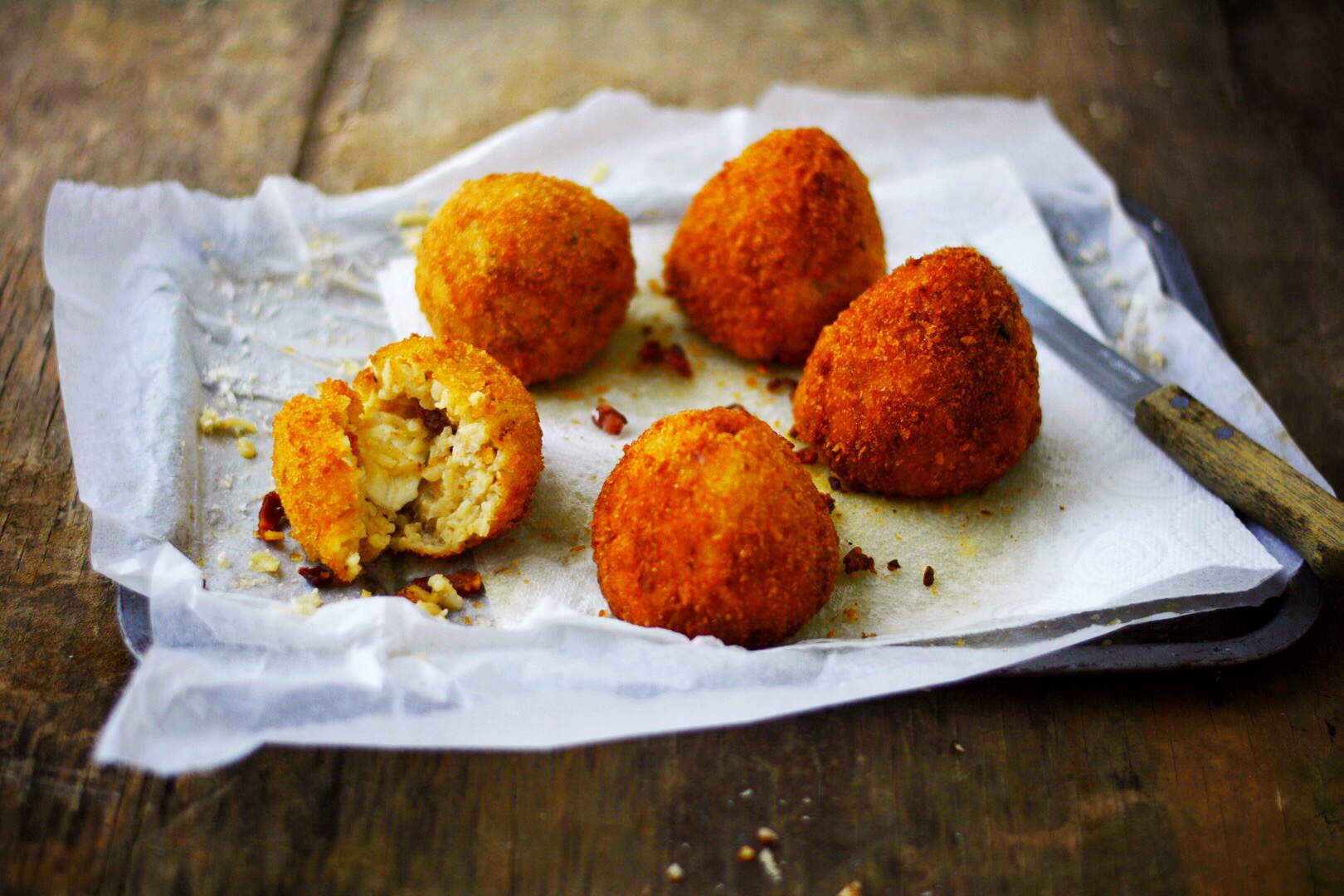
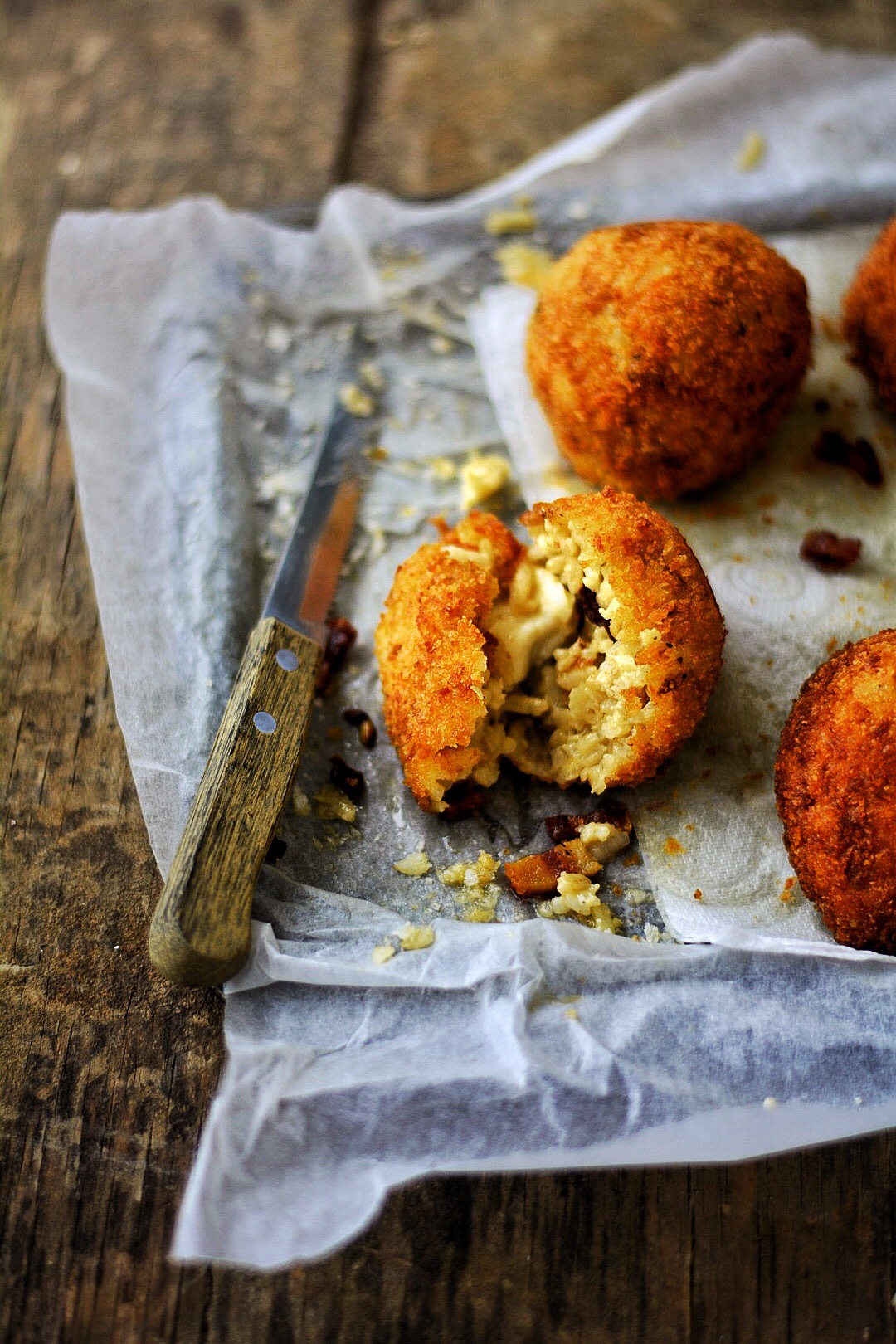

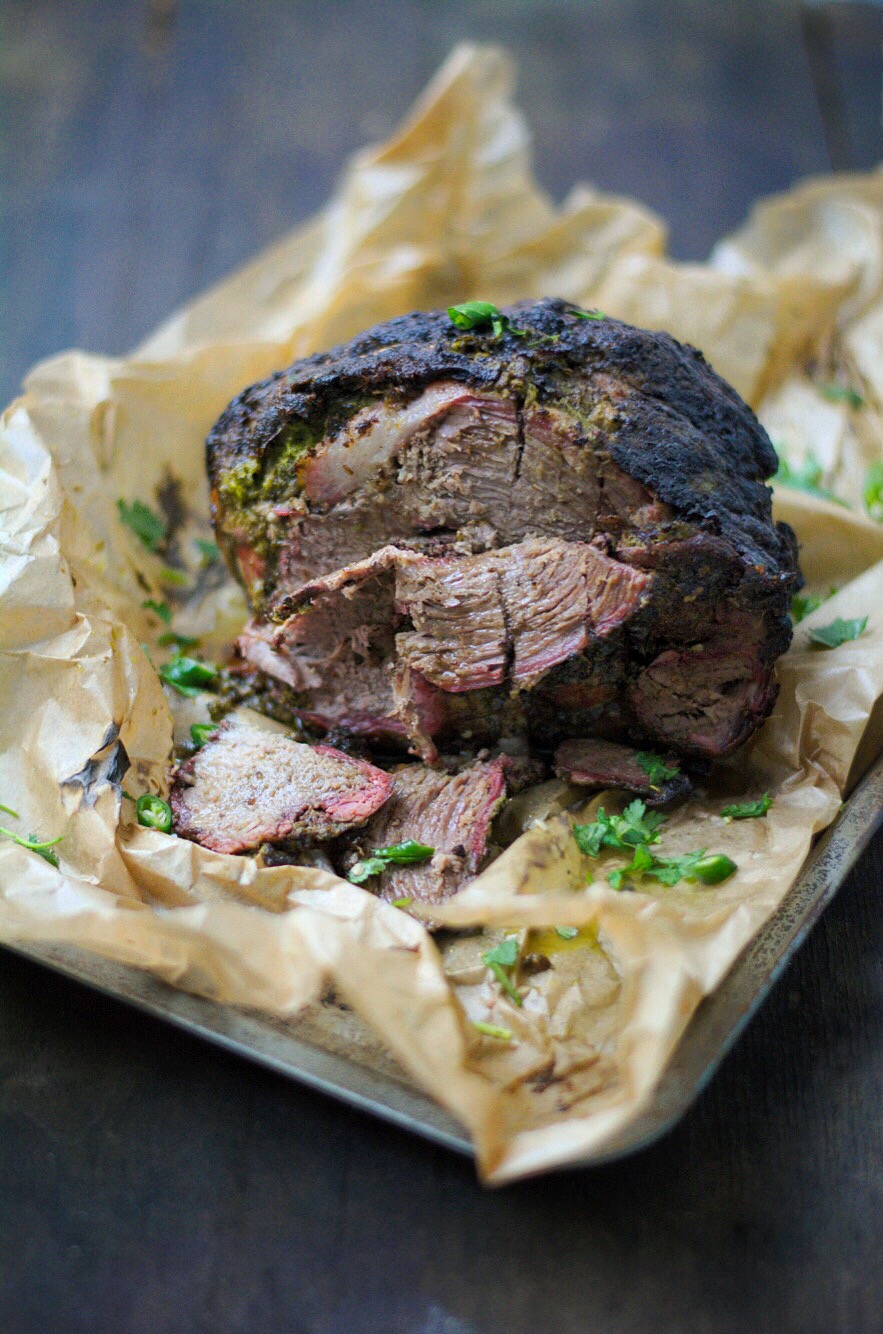
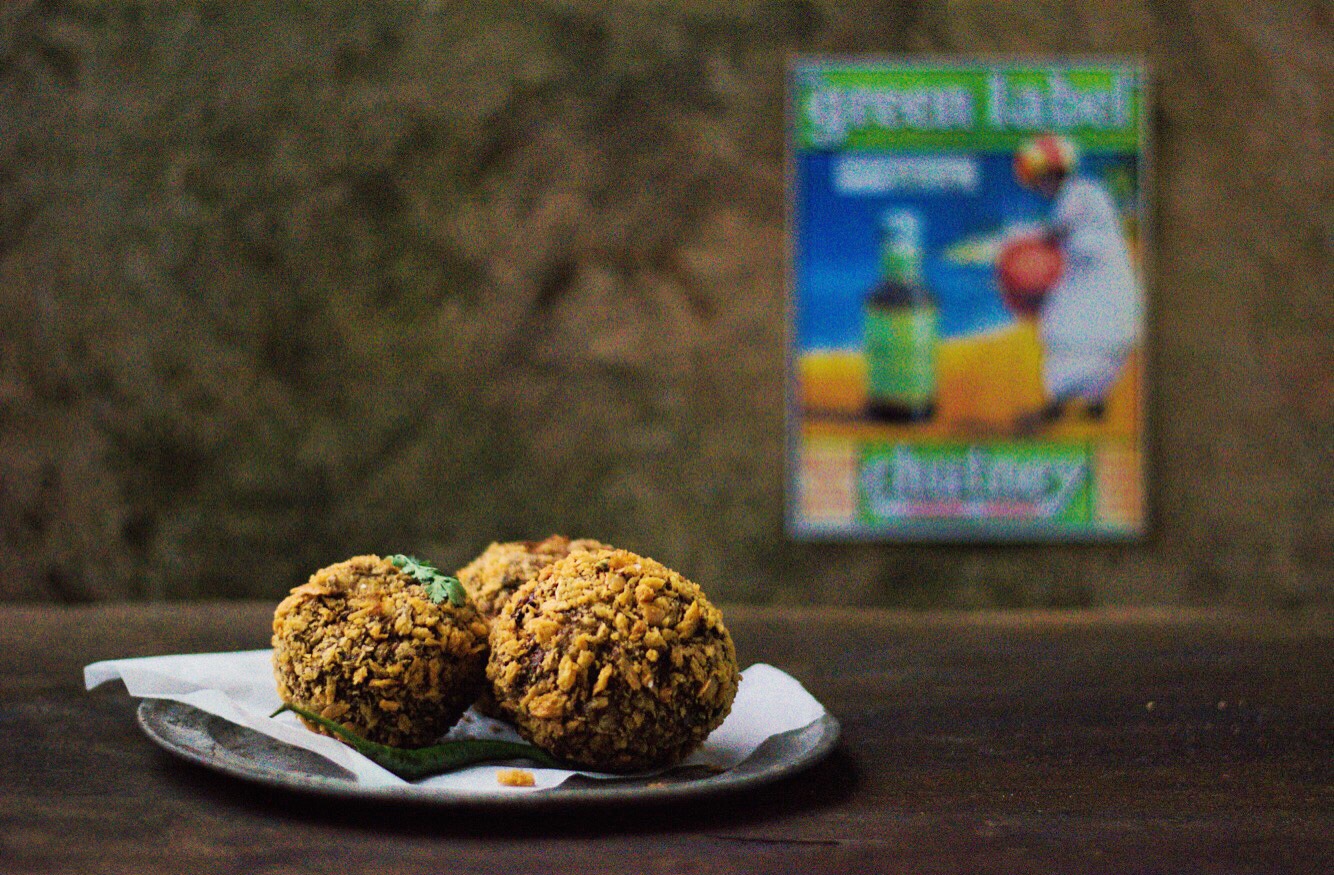
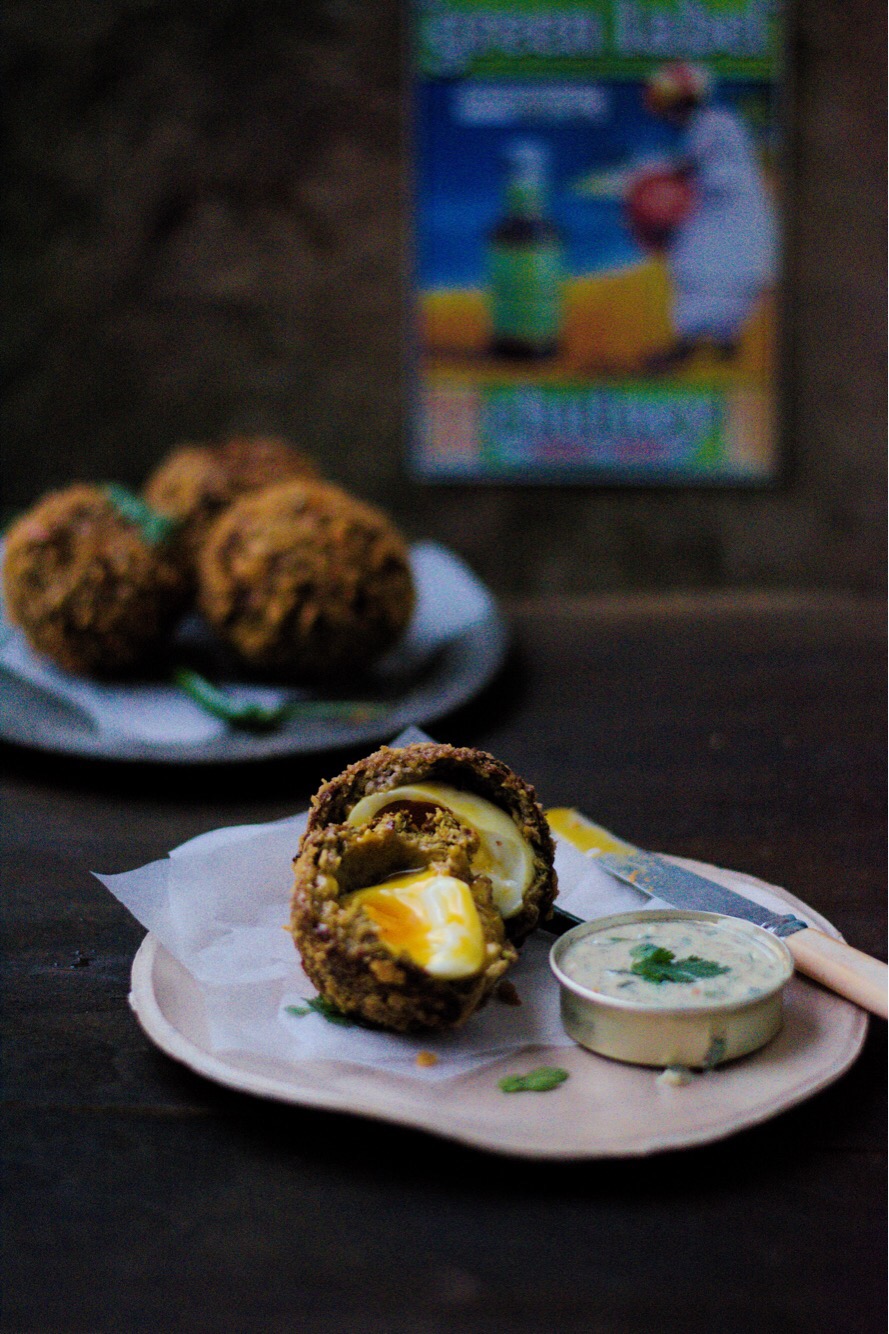 The petrol station. Where food goes to die. This is why people think badly of Scotch eggs, although, thankfully there has been a little positive renaissance recently of these picnic staples, and done well, they are delicious. There was even a recent trend for 'artisan scotch eggs' in the edgier areas of London. Although why you'd want an artisan to make your lunch rather than a cook is beyond me. It would probably be full of wood shavings and metal filings. And no doubt beard hair.There is much debate about the origin of this dish. I wonder if 'scotching' an egg means keeping it alive but rendering it harmless inside a case. Shakespeare says in Macbeth 'We have scotch'd the snake, not kill'd it’ (see, Mrs. Hutchings, I was paying attention at the back). But whatever the origin of the term, it doesn't seem to be used for any other dishes. And whatever the method or serving, egg wrapped in meat cannot fail to be a good thing. Unless you're vegan. Or vegetarian.Allegedly invented in the 18th century at Fortnum and Masons, the dish pops up all over the place if you look carefully behind the cushions. The one that excited me most of all was from Lucknow, in India. Their version is served in a rich, spicy gravy but here I've taken those flavours and added them to the meat itself then serve it with a yoghurt dipping sauce. A kind of Scotch egg curry. Bloody hell. And as with many British meals, our Empire travels, subjugation and plundering has given us a wide variety of dishes full of spice and exotic backgrounds. Every cloud and all that...Ingredients500g lamb minceA few tablespoons of paste made from onion, green chilli, garlic and ginger2tsp ground turmeric1tbsp ground cumin1tbsp chilli powder1tbsp ground cumin2tsp dried mint2tsp ground fenugreekSalt and pepper4 eggs, boiled for five and a half minutes then quickly cooled (I boiled mine for four minutes for a runny and explosive yolk filling, but you may want it firmer)Breadcrumbs (I used panko and crushed them a little) mixed with 1tbsp garam masala.For the dip:Natural yoghurtCoriander leaves, choppedMint leaves, choppedToasted flaked almonds1/2tsp grated garlic1/2tsp grated gingerPinch of ground cinnamon, ground cardamom and caraway seedsMethodMix the meat and spices together and wrap each egg in a layer of the mixture, making sure the whole egg is sealed. Do this gently, it's easy to squash them.Put in the fridge for an hour to chill and firm then roll each one in the breadcrumbs, pressing them into the meat.If you have a deep-fryer, this is what it was born for. If not, carefully cook them in oil in a deep and heavy pan, only half-filling it to avoid accidents and over spill.Heat the oil to 180c and cook the eggs, a couple at a time until golden brown all over. This will take about four to five minutes.Drain on kitchen paper and leave to cool a little before serving with the dip, extra green chillies and coriander leaves.
The petrol station. Where food goes to die. This is why people think badly of Scotch eggs, although, thankfully there has been a little positive renaissance recently of these picnic staples, and done well, they are delicious. There was even a recent trend for 'artisan scotch eggs' in the edgier areas of London. Although why you'd want an artisan to make your lunch rather than a cook is beyond me. It would probably be full of wood shavings and metal filings. And no doubt beard hair.There is much debate about the origin of this dish. I wonder if 'scotching' an egg means keeping it alive but rendering it harmless inside a case. Shakespeare says in Macbeth 'We have scotch'd the snake, not kill'd it’ (see, Mrs. Hutchings, I was paying attention at the back). But whatever the origin of the term, it doesn't seem to be used for any other dishes. And whatever the method or serving, egg wrapped in meat cannot fail to be a good thing. Unless you're vegan. Or vegetarian.Allegedly invented in the 18th century at Fortnum and Masons, the dish pops up all over the place if you look carefully behind the cushions. The one that excited me most of all was from Lucknow, in India. Their version is served in a rich, spicy gravy but here I've taken those flavours and added them to the meat itself then serve it with a yoghurt dipping sauce. A kind of Scotch egg curry. Bloody hell. And as with many British meals, our Empire travels, subjugation and plundering has given us a wide variety of dishes full of spice and exotic backgrounds. Every cloud and all that...Ingredients500g lamb minceA few tablespoons of paste made from onion, green chilli, garlic and ginger2tsp ground turmeric1tbsp ground cumin1tbsp chilli powder1tbsp ground cumin2tsp dried mint2tsp ground fenugreekSalt and pepper4 eggs, boiled for five and a half minutes then quickly cooled (I boiled mine for four minutes for a runny and explosive yolk filling, but you may want it firmer)Breadcrumbs (I used panko and crushed them a little) mixed with 1tbsp garam masala.For the dip:Natural yoghurtCoriander leaves, choppedMint leaves, choppedToasted flaked almonds1/2tsp grated garlic1/2tsp grated gingerPinch of ground cinnamon, ground cardamom and caraway seedsMethodMix the meat and spices together and wrap each egg in a layer of the mixture, making sure the whole egg is sealed. Do this gently, it's easy to squash them.Put in the fridge for an hour to chill and firm then roll each one in the breadcrumbs, pressing them into the meat.If you have a deep-fryer, this is what it was born for. If not, carefully cook them in oil in a deep and heavy pan, only half-filling it to avoid accidents and over spill.Heat the oil to 180c and cook the eggs, a couple at a time until golden brown all over. This will take about four to five minutes.Drain on kitchen paper and leave to cool a little before serving with the dip, extra green chillies and coriander leaves.
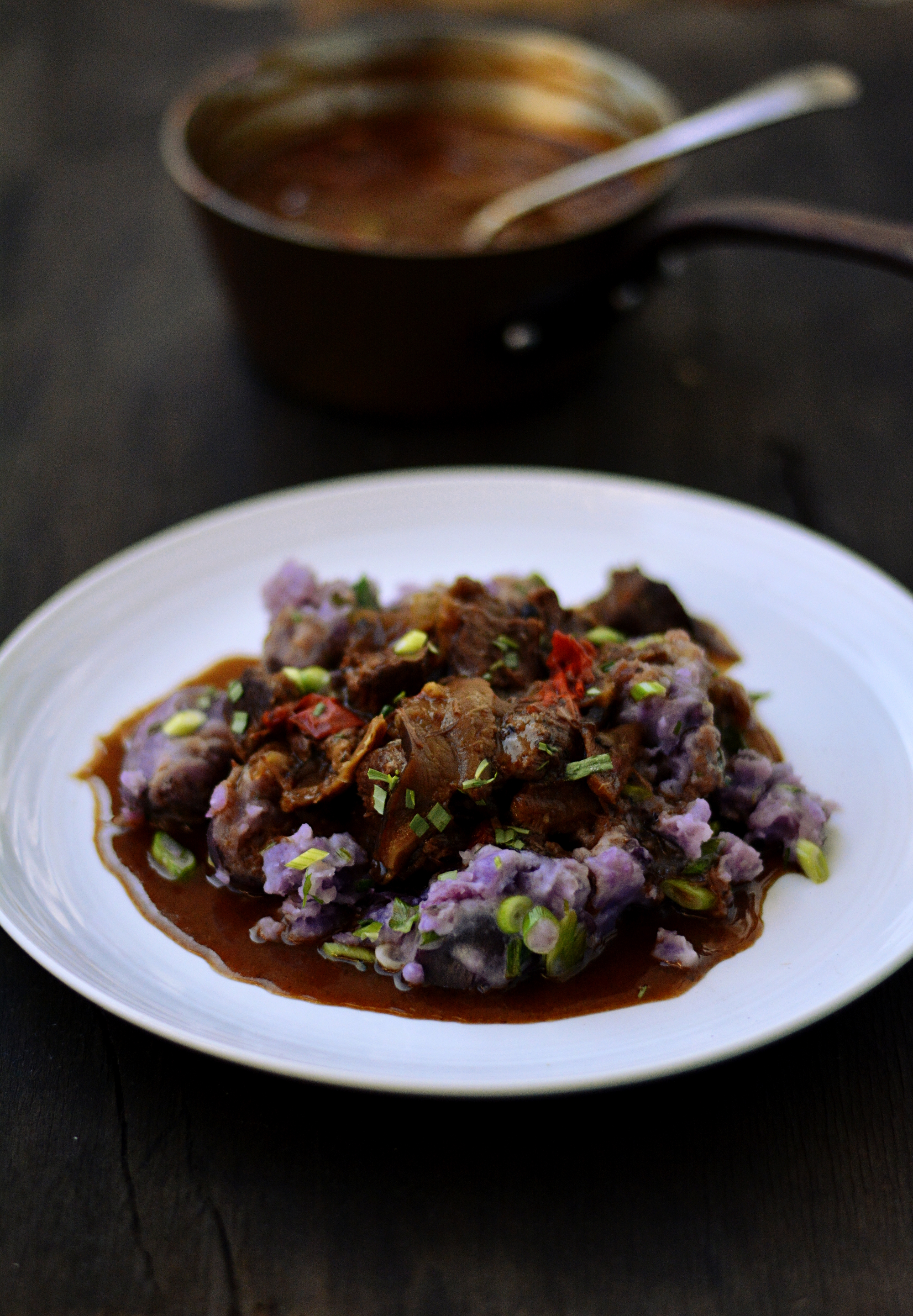 The slow change from vivid green to red, yellow, orange. And then how quickly the trees become bare and the glorious colours give way to brown and grey sludgy streets.In the seemingly few hours of daylight we have over the winter months we celebrate the warmth of the fireside. Scarves, gloves, hats and thick woolen jumpers wrapped around us keep us cosy when we venture outside, often leaving and returning home in the dark.I welcome the smells from the slow cooker more than any dog's wagging tail as a greeting. And here we are, only at the gentle tip of the cold months, yet it feels like it's the time for stews. Meat falling from bones into rich and thick broths, individual flavours combining like the instruments in an orchestra to create one symphony.A cast-iron pan with a lid in a very low oven does just as well as a slow cooker, and if you're happy leaving the oven on all day it's the perfect way to cook. However, you may not fancy chopping and browning chunks of meat while drinking your morning coffee and wondering why you have to ask the children twenty times to put a sock on. I have neither the time nor inclination, getting out of a warm bed is tragedy enough. In which case these are best done the night before, or on a weekend when you have a more leisurely start to the day.Of course white potatoes work just as well as the purple ones, which may be a little tricky to find; crushed Anyas would be a real treat. Whatever you use, nothing quite beats the deliciousness of all those juices soaked up by the buttery potatoes. This really is one of those meals that feels like you're back home in the warmth of the family.Tarragon adds a little last of the summer sparkle to the flavours, hinting with its warm aniseed at the comfort to come. If you don't have any, a good handful of chopped parsley running through would be just as nice.Ingredients500g ox cheek, cut into chunks1 onion, roughly choppedA thumb of ginger, chopped1tbsp oregano1tbsp flour1/2 a bulb of garlic1 red pepper, chopped2tbsp tomato purée500ml beef stockLarge pinch of dried mushroomsSalt and pepperPotatoes to serve, cooked and crushed with butter, spring onion and some shredded tarragon.MethodHeat a heavy sauté pan with some oil and sear the beef well until browned. Try not to smoke out the kitchen and set of the smoke alarms in a panicked succession as I did. And sear the meat in batches to avoid boiling rather than caramelising it.Add the flour and stir well, coating all the meat. This will help thicken the sauce. Add to the slow cooker or casserole. Deglaze the sauté pan with a little water or wine and add the juices along with the remaining ingredients.Cook on high for four hours or low for eight hours in the slow cooker, or eight hours in a very low oven. (140c. Gas mark 1) Serve with the potatoes and perhaps some broccoli or garlic green beans.
The slow change from vivid green to red, yellow, orange. And then how quickly the trees become bare and the glorious colours give way to brown and grey sludgy streets.In the seemingly few hours of daylight we have over the winter months we celebrate the warmth of the fireside. Scarves, gloves, hats and thick woolen jumpers wrapped around us keep us cosy when we venture outside, often leaving and returning home in the dark.I welcome the smells from the slow cooker more than any dog's wagging tail as a greeting. And here we are, only at the gentle tip of the cold months, yet it feels like it's the time for stews. Meat falling from bones into rich and thick broths, individual flavours combining like the instruments in an orchestra to create one symphony.A cast-iron pan with a lid in a very low oven does just as well as a slow cooker, and if you're happy leaving the oven on all day it's the perfect way to cook. However, you may not fancy chopping and browning chunks of meat while drinking your morning coffee and wondering why you have to ask the children twenty times to put a sock on. I have neither the time nor inclination, getting out of a warm bed is tragedy enough. In which case these are best done the night before, or on a weekend when you have a more leisurely start to the day.Of course white potatoes work just as well as the purple ones, which may be a little tricky to find; crushed Anyas would be a real treat. Whatever you use, nothing quite beats the deliciousness of all those juices soaked up by the buttery potatoes. This really is one of those meals that feels like you're back home in the warmth of the family.Tarragon adds a little last of the summer sparkle to the flavours, hinting with its warm aniseed at the comfort to come. If you don't have any, a good handful of chopped parsley running through would be just as nice.Ingredients500g ox cheek, cut into chunks1 onion, roughly choppedA thumb of ginger, chopped1tbsp oregano1tbsp flour1/2 a bulb of garlic1 red pepper, chopped2tbsp tomato purée500ml beef stockLarge pinch of dried mushroomsSalt and pepperPotatoes to serve, cooked and crushed with butter, spring onion and some shredded tarragon.MethodHeat a heavy sauté pan with some oil and sear the beef well until browned. Try not to smoke out the kitchen and set of the smoke alarms in a panicked succession as I did. And sear the meat in batches to avoid boiling rather than caramelising it.Add the flour and stir well, coating all the meat. This will help thicken the sauce. Add to the slow cooker or casserole. Deglaze the sauté pan with a little water or wine and add the juices along with the remaining ingredients.Cook on high for four hours or low for eight hours in the slow cooker, or eight hours in a very low oven. (140c. Gas mark 1) Serve with the potatoes and perhaps some broccoli or garlic green beans.
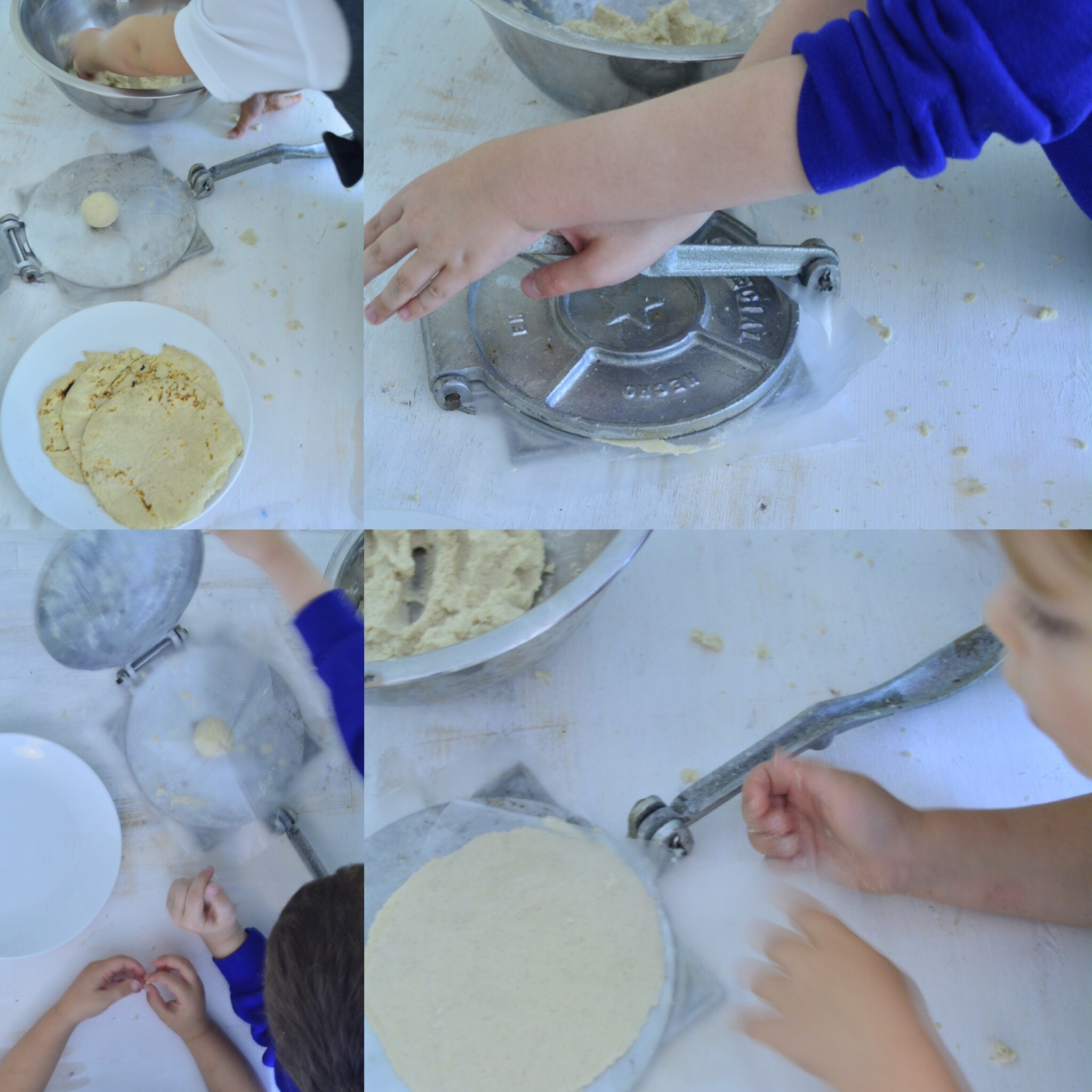




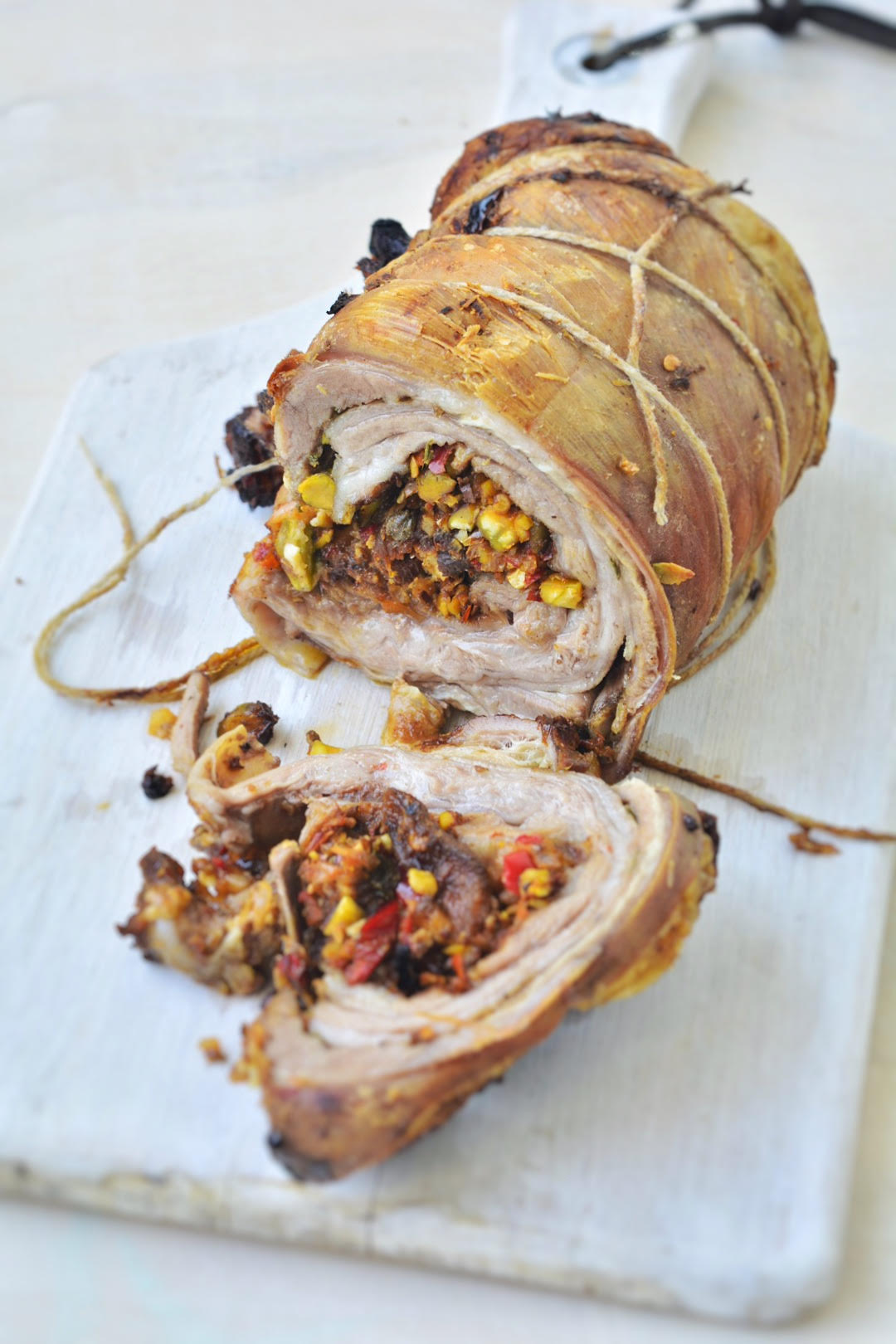 I prefer Autumn lamb, more flavoursome than spring and in my mind, less mean-spirited to eat. It's had a chance to gambol about and is saved from the misery of the long dark days of winter. It will never know what it's like to leave the shed first thing in the morning in the dark and come home after a hard day still in the dark. It's had one glorious summer.Harissa, garlic and rosemary were born to go with lamb. Spread all over a leg and studded through is a heavenly mix. Here though, I've stuffed the breast with a few other bits and pieces then rolled it tightly, slowly roasting it, at first on high to crisp the skin, then slowly for a few more hours so all the flavours melt into each other. Once you've done the chopping, which is a pretty quick job, you can just put it in the oven and you're free to do some gambolling of your own.We ate this with a butter bean mash laced with lemon juice to cut through the richness. All you need for this is a tin of butter beans, the juice of half a lemon, some salt and thyme sprigs. Heat them all together in a pan and crush until mashed.Ingredients1kg lamb breastA few thyme sprigs, leaves only1tbsp cumin seedsSalt and pepper3tbsp harissa1/2 red onion, sliced1 red chilli, finely sliced1 fat garlic cloveFor the stuffing6 dried apricots, preferably the natural black ones, choppedA handful of pistachios, crushed1tsp capers1tbsp ground cinnamon1/2 block of fetaMethodHeat the oven to 220cRoll back the layers of meat and sprinkle the thyme and cumin seeds under the first layer of skin.Lay the next layer back down and spread all over with the harissa then sprinkle over the pistachio. Spread over the onion, garlic and chilli then the apricot and capers.Crumble over the feta and sprinkle on the cinnamon.Tightly roll the lamb and tie it well all round with string.Cook for half an hour then turn the oven down to 150c and cook for another two and a half hours. Leave to rest and carve into slices.
I prefer Autumn lamb, more flavoursome than spring and in my mind, less mean-spirited to eat. It's had a chance to gambol about and is saved from the misery of the long dark days of winter. It will never know what it's like to leave the shed first thing in the morning in the dark and come home after a hard day still in the dark. It's had one glorious summer.Harissa, garlic and rosemary were born to go with lamb. Spread all over a leg and studded through is a heavenly mix. Here though, I've stuffed the breast with a few other bits and pieces then rolled it tightly, slowly roasting it, at first on high to crisp the skin, then slowly for a few more hours so all the flavours melt into each other. Once you've done the chopping, which is a pretty quick job, you can just put it in the oven and you're free to do some gambolling of your own.We ate this with a butter bean mash laced with lemon juice to cut through the richness. All you need for this is a tin of butter beans, the juice of half a lemon, some salt and thyme sprigs. Heat them all together in a pan and crush until mashed.Ingredients1kg lamb breastA few thyme sprigs, leaves only1tbsp cumin seedsSalt and pepper3tbsp harissa1/2 red onion, sliced1 red chilli, finely sliced1 fat garlic cloveFor the stuffing6 dried apricots, preferably the natural black ones, choppedA handful of pistachios, crushed1tsp capers1tbsp ground cinnamon1/2 block of fetaMethodHeat the oven to 220cRoll back the layers of meat and sprinkle the thyme and cumin seeds under the first layer of skin.Lay the next layer back down and spread all over with the harissa then sprinkle over the pistachio. Spread over the onion, garlic and chilli then the apricot and capers.Crumble over the feta and sprinkle on the cinnamon.Tightly roll the lamb and tie it well all round with string.Cook for half an hour then turn the oven down to 150c and cook for another two and a half hours. Leave to rest and carve into slices.
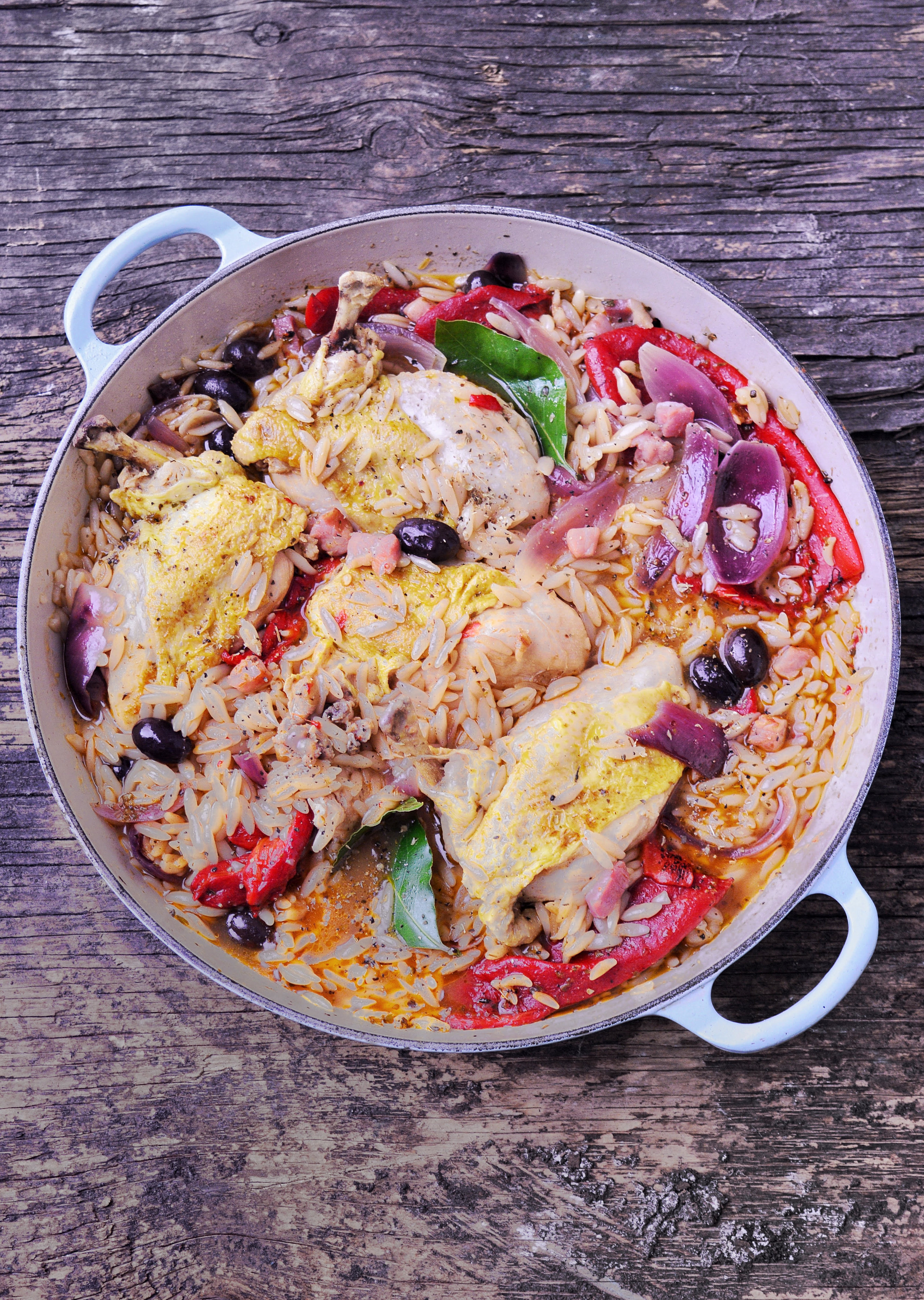 And the nights are drawing in. Summer's almost gone, before we know it we shall be wearing makeup and knocking on neighbours doors demanding sweets. Even if you don't have children, this is great fun. I'd even suggest doing it mid-July if you fancy a laugh.But before then, it's my favourite time of year. The leaves turn gold and orange, the crisp, blue mornings with their low sun skies turn the walk to school into a show of colour and misty breath, wrapped up against the coming winter. It's the time to eat comforting food that's not quite long slow-braised beef shin stews, thick, rich and brown, but bridges the seasons.Cooking the pasta in the pan with everything else gives it real depth and reminds me of some of the meal in a bowl soups my mum used to make for us. There's so much going on, but really takes very little effort to make. Fresh bay leaves from the tree make the difference here, but use dried if you must. And don't bother doing your own peppers, just buy a good jar of them. There are some things that just aren't worth the fuss.Ingredients for four4 skin on chicken supremes4 garlic cloves, peeled1 red onion, cut into wedges1tbsp dried oregano2 bay leaves1 jar of roast red peppers, drainedA handful of good black olives250g orzo1tsp bouillon powderBoiling water to coverOlive oilSalt and pepper to seasonMethodHeat some oil in a large, lidded, heavy and shallow pan. Fry the chicken, seasoned, skin-side down until golden then turn and cook for a couple of minutes.Add the garlic and onions and cook for a minute longer.Throw in the peppers, olives, bay, bouillon, and orzo then just cover with boiling water. Sprinkle over the oregano and cover with the lid.Cook gently for about ten minutes, until the orzo is soft, but with a little bite.Serve from the pan at the table.
And the nights are drawing in. Summer's almost gone, before we know it we shall be wearing makeup and knocking on neighbours doors demanding sweets. Even if you don't have children, this is great fun. I'd even suggest doing it mid-July if you fancy a laugh.But before then, it's my favourite time of year. The leaves turn gold and orange, the crisp, blue mornings with their low sun skies turn the walk to school into a show of colour and misty breath, wrapped up against the coming winter. It's the time to eat comforting food that's not quite long slow-braised beef shin stews, thick, rich and brown, but bridges the seasons.Cooking the pasta in the pan with everything else gives it real depth and reminds me of some of the meal in a bowl soups my mum used to make for us. There's so much going on, but really takes very little effort to make. Fresh bay leaves from the tree make the difference here, but use dried if you must. And don't bother doing your own peppers, just buy a good jar of them. There are some things that just aren't worth the fuss.Ingredients for four4 skin on chicken supremes4 garlic cloves, peeled1 red onion, cut into wedges1tbsp dried oregano2 bay leaves1 jar of roast red peppers, drainedA handful of good black olives250g orzo1tsp bouillon powderBoiling water to coverOlive oilSalt and pepper to seasonMethodHeat some oil in a large, lidded, heavy and shallow pan. Fry the chicken, seasoned, skin-side down until golden then turn and cook for a couple of minutes.Add the garlic and onions and cook for a minute longer.Throw in the peppers, olives, bay, bouillon, and orzo then just cover with boiling water. Sprinkle over the oregano and cover with the lid.Cook gently for about ten minutes, until the orzo is soft, but with a little bite.Serve from the pan at the table.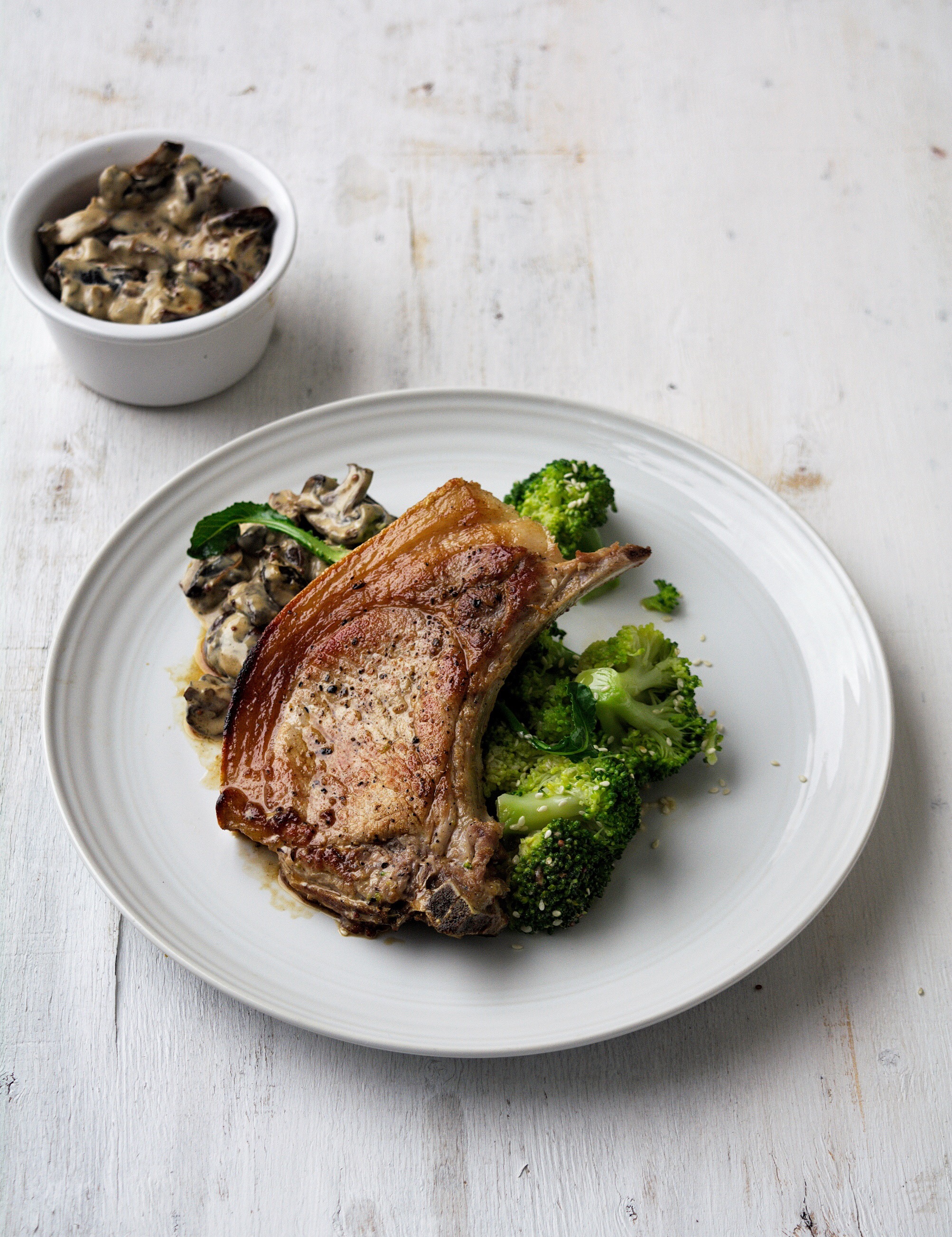

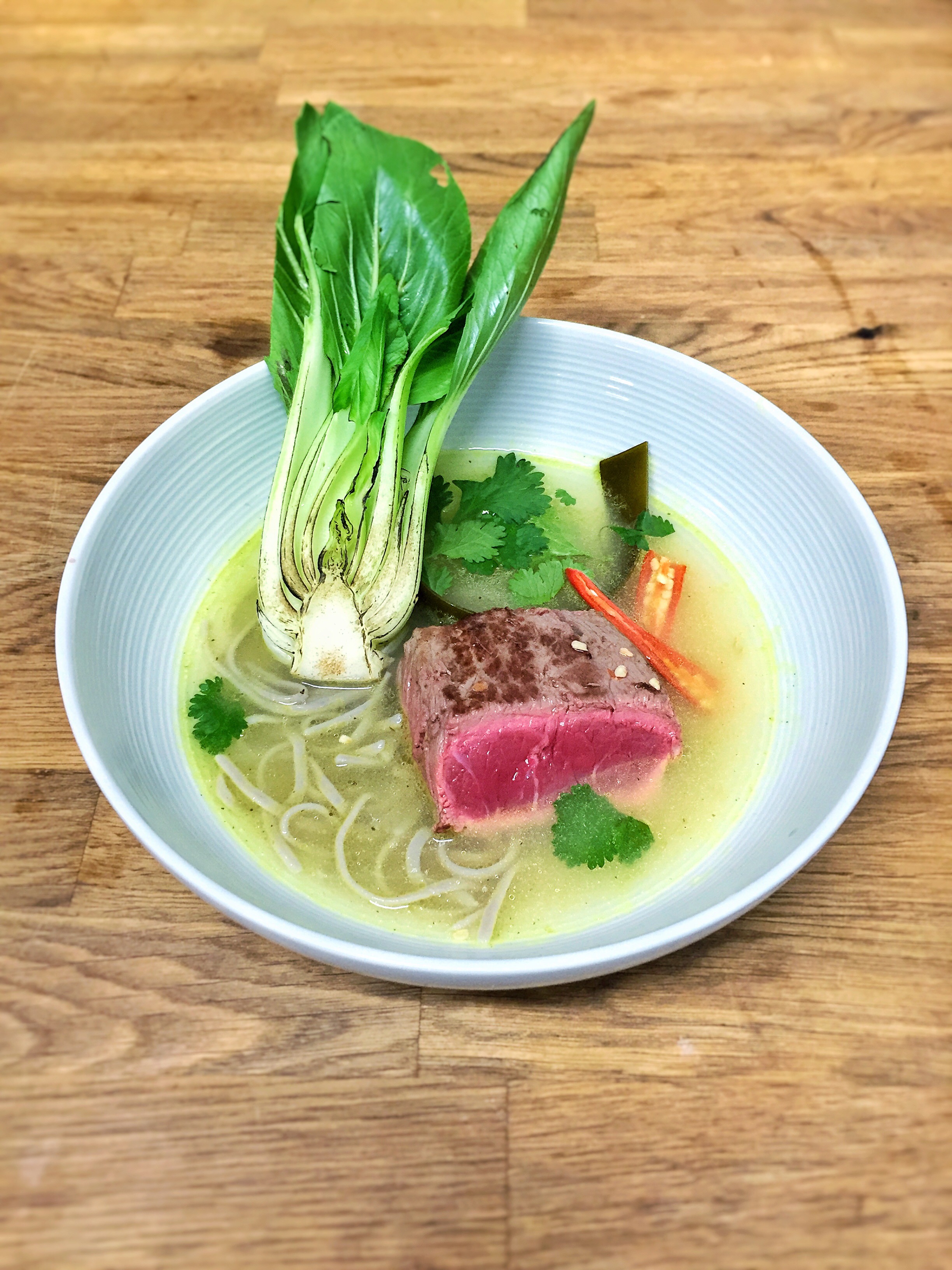




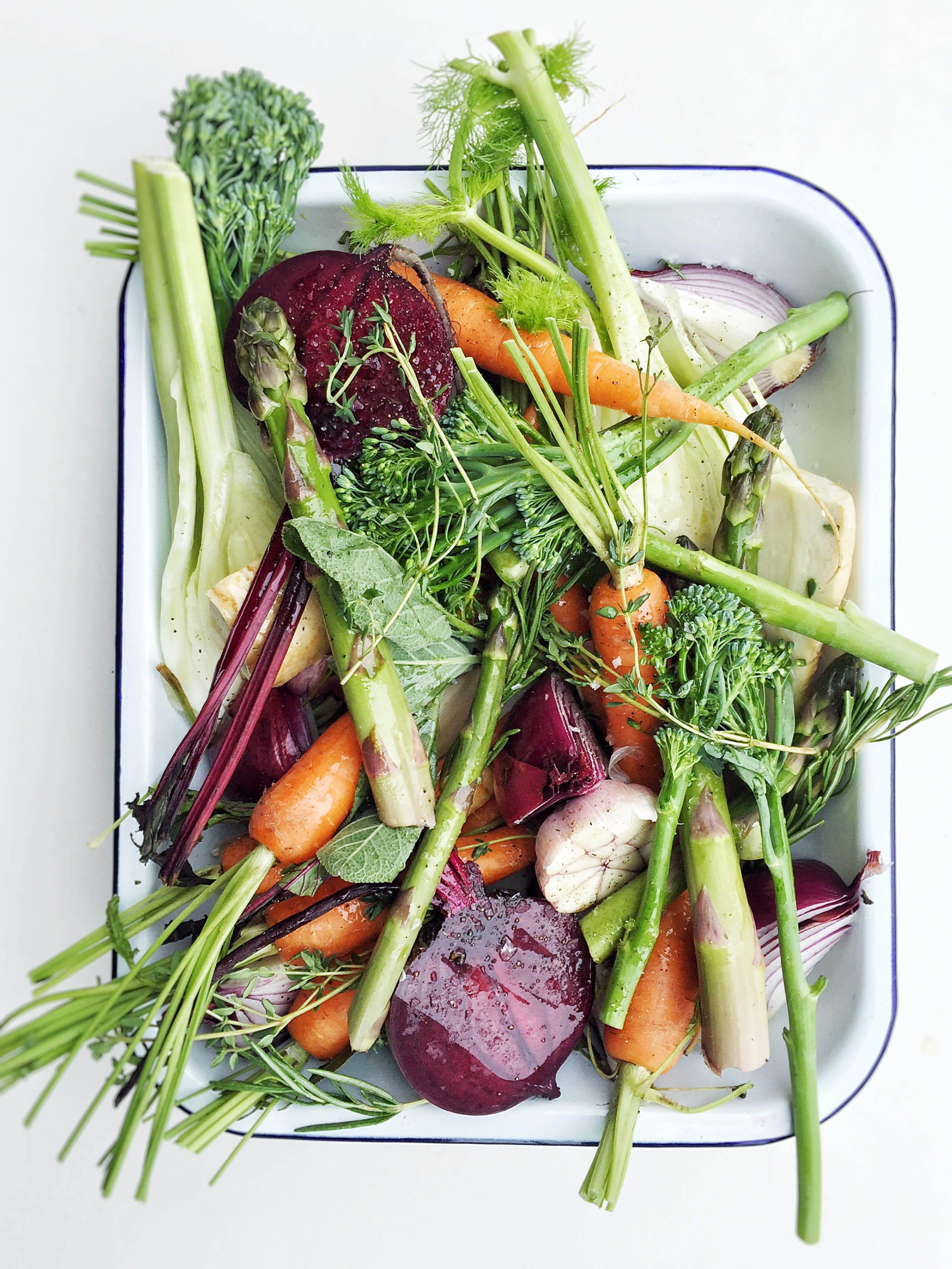 Throwing a load of vegetables in a tin with some herbs, oil, salt and pepper is about as easy as cooking gets. Easier than boiling an egg, even. It's a great accompaniment to roast meat and steamed fish and gets a load of different colours on your plate. I love picking out the caramelised, sticky and juicy bits that have caught in the pan while roasting, it's such a comforting and delicious treat that the cook gets all to their sneaky self.Often I'll roast a chicken or joint of pork on top of the veg, that's a real treat. The meat takes on a deep flavour, and the juices in the pan are so rich and delicious, you just pour them over, there's no need to make a sauce.I've even roasted a load of sausages in among the vegetables, a perfect one pot meal. All it takes is a little peeling and chopping then the oven does the rest. You can throw in some tomatoes too, they give off their juices and mingle deliciously with the other veg. Fennel softens beautifully, giving off its light, mellow aniseed to the pot and onions turn golden, sticky and sweet.Use what is available at the time and keep an eye on it while cooking so it doesn't burn. 35-45 minutes at 180c is normally about right, depending on what veg you use. One tip I'd give is to have the more delicate vegetables at the bottom and harder ones such as beetroot, carrots and the like on top.Drizzle everything in olive oil and season well with salt and pepper. Mix through some hardy herbs such as rosemary, sage and bay leaves and finish off with some young thyme and perhaps chilli flakes as it comes out the oven. Put it straight on the table and dig in.
Throwing a load of vegetables in a tin with some herbs, oil, salt and pepper is about as easy as cooking gets. Easier than boiling an egg, even. It's a great accompaniment to roast meat and steamed fish and gets a load of different colours on your plate. I love picking out the caramelised, sticky and juicy bits that have caught in the pan while roasting, it's such a comforting and delicious treat that the cook gets all to their sneaky self.Often I'll roast a chicken or joint of pork on top of the veg, that's a real treat. The meat takes on a deep flavour, and the juices in the pan are so rich and delicious, you just pour them over, there's no need to make a sauce.I've even roasted a load of sausages in among the vegetables, a perfect one pot meal. All it takes is a little peeling and chopping then the oven does the rest. You can throw in some tomatoes too, they give off their juices and mingle deliciously with the other veg. Fennel softens beautifully, giving off its light, mellow aniseed to the pot and onions turn golden, sticky and sweet.Use what is available at the time and keep an eye on it while cooking so it doesn't burn. 35-45 minutes at 180c is normally about right, depending on what veg you use. One tip I'd give is to have the more delicate vegetables at the bottom and harder ones such as beetroot, carrots and the like on top.Drizzle everything in olive oil and season well with salt and pepper. Mix through some hardy herbs such as rosemary, sage and bay leaves and finish off with some young thyme and perhaps chilli flakes as it comes out the oven. Put it straight on the table and dig in.
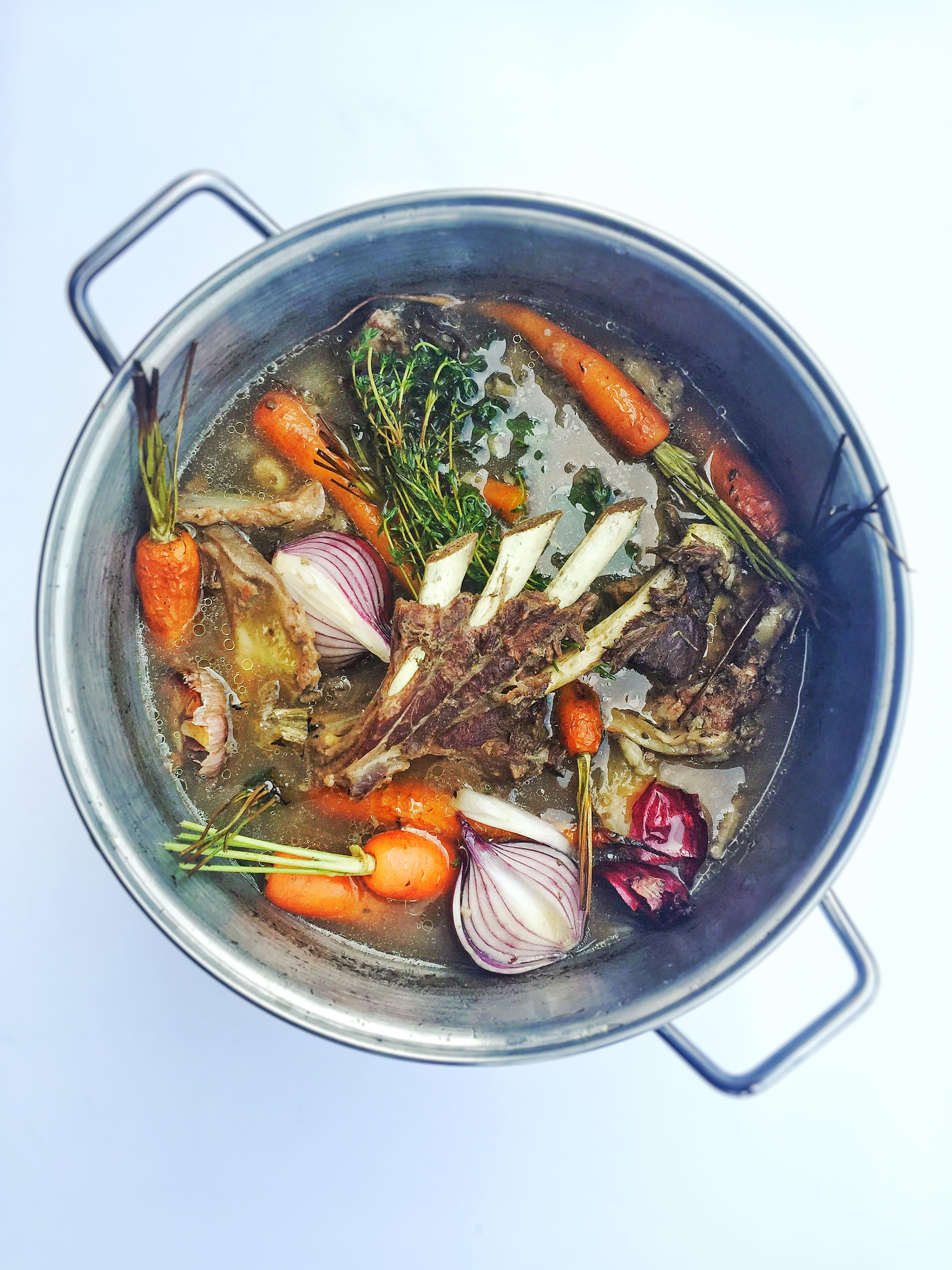 When I worked in the restaurant, every afternoon we made big simmering vats of stock which we would then reduce overnight. Each time, we would peel and halve kilos of onions, throw in countless chicken carcasses and pigs feet, top and tail sacks of carrots before peeling them then leave the lot to gently poach for hours. This was not a one person job. Nor was it a particularly fragrant one, either. I'm grateful I didn't have to sit next to myself on the train home.Bee complains about the smell whenever I make stock at home. Generally, it's only chicken based, but occasionally I get a few bags of bones from the butcher and return to the restaurant method to make a deep, rich broth, meaty and gelatinous and full of flavour. For me, the smell of stock cooking is comforting, homely and cosy. It speaks of the nourishing meals to come, from ragùs to Thai broths, fancy sauces to simple soups.All you need to do is get the largest and deepest pan you have, get a load of bones from your butcher as well as plenty of carrots and onions (peeled) and throw them all in. Cover with water, bring to the boil and let simmer for at least six hours. Add some herbs such as thyme, rosemary and bay for the last hour or so then leave to cool. You can use it now if you like, (strained) but I prefer to add another stage just to really concentrate the flavours:The next day (unless you fancy doing it right away, up to you), remove all the bones and vegetables, throw them out and strain the stock back into the pan.Bring to the boil for ten minutes then simmer until reduced by about half. Let it cool then cover and put in the fridge. It freezes well, so if you have plenty you may want to do this. If not, it should keep for about five days. It may seem like a long process, but I promise your gravy will be amazing.
When I worked in the restaurant, every afternoon we made big simmering vats of stock which we would then reduce overnight. Each time, we would peel and halve kilos of onions, throw in countless chicken carcasses and pigs feet, top and tail sacks of carrots before peeling them then leave the lot to gently poach for hours. This was not a one person job. Nor was it a particularly fragrant one, either. I'm grateful I didn't have to sit next to myself on the train home.Bee complains about the smell whenever I make stock at home. Generally, it's only chicken based, but occasionally I get a few bags of bones from the butcher and return to the restaurant method to make a deep, rich broth, meaty and gelatinous and full of flavour. For me, the smell of stock cooking is comforting, homely and cosy. It speaks of the nourishing meals to come, from ragùs to Thai broths, fancy sauces to simple soups.All you need to do is get the largest and deepest pan you have, get a load of bones from your butcher as well as plenty of carrots and onions (peeled) and throw them all in. Cover with water, bring to the boil and let simmer for at least six hours. Add some herbs such as thyme, rosemary and bay for the last hour or so then leave to cool. You can use it now if you like, (strained) but I prefer to add another stage just to really concentrate the flavours:The next day (unless you fancy doing it right away, up to you), remove all the bones and vegetables, throw them out and strain the stock back into the pan.Bring to the boil for ten minutes then simmer until reduced by about half. Let it cool then cover and put in the fridge. It freezes well, so if you have plenty you may want to do this. If not, it should keep for about five days. It may seem like a long process, but I promise your gravy will be amazing.